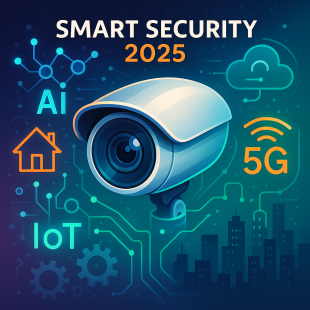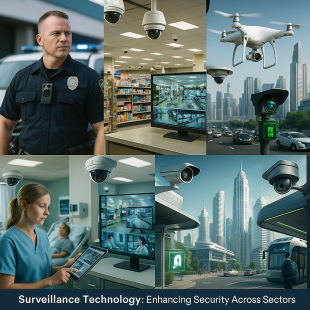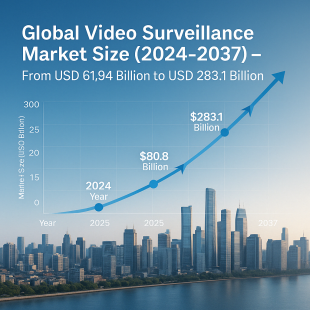Outlook 2025: Key Technology and Market Trends in Security Surveillance
According to recent market reports and industry analyses, the global security surveillance market is undergoing significant technological innovation and market expansion towards 2025. This sharing is based on the available data to provide you with an analysis of the key trends and technological directions for the future.Market Size and Growth MomentumThe global security and surveillance market is expected to experience strong growth in the coming years. One report predicts that by 2029, the market size will grow to USD 28.15 billion, with a Compound Annual Growth Rate (CAGR) of 7.7%. Another report focusing on the global surveillance camera market forecasts the market size to reach USD 81.37 billion by 2030, growing at a CAGR of 11.2% from 2025 to 2030. Furthermore, one report indicates that the global surveillance camera market will grow by USD 3.85 billion between 2025 and 2029, with a CAGR of 12.1%. The European video surveillance market (excluding services) is also projected to grow at a CAGR of 15.5% between 2024 and 2029. While these different figures vary slightly, they collectively point to a trend of high market growth.
Key factors driving market growth include:
Increasing globalization and cross-border threats.
The rise in terrorism and illegal activities, leading to increased demand for security and surveillance measures to detect and prevent such acts
Increased public awareness and trust
The influence of economic factors
The emergence of new threats
Growth in public and private infrastructure
Increasing adoption of smart technologies in the Internet of Things (IoT) and smart cities
Continuous technological advancements in video surveillance solutions.
Core Technology Development Trends
The focus of technological innovation in the security surveillance field in 2025 is on intelligence, cloud-based solutions, and automation. Here are some key technology trends worth noting:
Artificial Intelligence (AI) and Machine Learning (ML): AI is one of the core technologies driving the intelligent upgrade of surveillance systems.
Major market players are actively investing in AI surveillance technology to enhance security measures and improve threat detection capabilities.
AI analyzes vast datasets through advanced algorithms and machine learning to detect anomalies, thereby increasing the efficiency of monitoring and response in various environments.
I video analysis can identify people, vehicles, and objects, understand "normal behavior," and automatically detect anomalies and alert in real-time, significantly reducing the burden of manual monitoring.
The application of AI also helps in real-time analysis of audio and video to quickly identify targets, events, and actions. AI-powered features such as object detection, behavioral analysis, and predictive analytics are expected to become prevalent to enhance the overall effectiveness and intelligence of surveillance systems. The security industry has become one of the main application areas for the deep integration of artificial intelligence and the real economy.
Edge Computing: Edge computing enables cameras to process data themselves, allowing for real-time analysis of images on the device, reducing latency and bandwidth load when transmitting data back to servers. This is particularly important for situations requiring immediate response. As the price of AI chips decreases, more smart cameras are expected to have edge computing capabilities. In China, front-end perception and edge computing are already in a leading position globally. The significant increase in AI computing power can also meet the growing demand for edge computing power.
Cloud-based Surveillance Solutions and VSaaS (Video Surveillance as a Service): Cloud-based surveillance solutions are a major trend during the forecast period. VSaaS solutions are increasingly popular, allowing businesses to access features like remote monitoring, automatic updates, and data backup through subscription without building expensive IT infrastructure. This model saves costs and allows for flexible resource adjustment. The need for remote access to live and recorded video footage gained significant attention in the post-pandemic era.
Integration of the Internet of Things (IoT): IoT integration is a key trend in the market forecast period. The application of IoT technology in the security sector is of significant importance for establishing a robust community public safety IoT system. It allows security equipment to connect and achieve interaction and rapid transmission of information. The intelligent advancement of video technology has also made video identification the second most important means of IoT perception after radio frequency identification. The rapid adoption of IoT in smart homes is supporting market growth. IoT technology promotes the improvement of service efficiency in the video surveillance industry.
5G Transmission: The high bandwidth and low latency characteristics of 5G networks make them an ideal solution for wireless cameras and mobile surveillance systems. It significantly improves image resolution and supports multi-channel high-definition video transmission. The widespread application of 5G technology will help ultra-high-definition video surveillance in the security sector develop in a faster, clearer, and more intelligent direction. Demand for surveillance cameras equipped with 5G is expected to increase.
IP Cameras Fully Replacing Analog Equipment: IP (Internet Protocol) cameras are gradually becoming the market mainstream due to their higher image quality, more stable transmission, support for AI analysis, and remote management. They are expected to completely replace traditional analog equipment. IP cameras can transmit digital signals via Wi-Fi or Ethernet, reducing the risk of signal degradation and facilitating integration with smart buildings or IoT systems.
Thermal Imaging Technology: By detecting changes in thermal energy, thermal cameras can identify targets regardless of lighting conditions, operating stably in darkness, dense fog, or harsh weather. They are increasingly valued in high-risk areas (such as border control, night patrols, power plants, and energy facilities). When combined with AI, they can accurately identify human thermal signatures and trigger alarms. The application of AI has significant benefits for thermal cameras.
System Integration and IoT Applications: Surveillance cameras are not only security tools but also part of smart building and operational management. By connecting with systems like access control, lighting, and HVAC, actions can be triggered based on video analysis, such as adjusting lights or managing pedestrian flow. Integrating camera data from different areas can achieve cross-area monitoring in larger buildings. The application of smart video technology is accelerating integration into smart cities and various industries.
Integrated Cybersecurity Protection: As networked IP cameras become widespread, their cybersecurity issues are facing significant challenges. Companies are adopting measures such as two-factor authentication, encrypted transmission, and regular firmware updates to strengthen defenses. The strategy of "integrated protection" that combines security systems with cybersecurity protection has become a technical trend. As IoT development poses higher requirements for network and data security, it is necessary to design and deploy comprehensive security protection measures to build an overall security defense system that is "threat perceivable, behavior detectable, attack preventable, and incident manageable". Research on data security technologies such as signing, encryption, access control, and privacy computing is also an important direction. Cybersecurity is not just a compliance requirement; it is a long and continuous journey. Market Segmentation Insights
Product Type: Surveillance cameras are a major product category. IP-based cameras are the mainstream, while cellular cameras are expected to be the fastest-growing segment during the forecast period. DVRs and NVRs (Digital Video Recorders and Network Video Recorders) are also major categories. These categories include Analog DVR Systems, IP-based NVR Systems, Hybrid DVR/NVR Systems, Cloud-based DVR/NVR Systems, and Standalone DVR/NVR Systems. The main categories also include security cameras.
Technology Type: Includes video surveillance, smart home security, information technology (IT) security, and workplace surveillance.
Resolution Capacity: Ultra High Definition (UHD) (4K) is anticipated to be the fastest-growing segment during the forecast period. This is driven by the increasing development of UHD or 4K resolution surveillance cameras that provide high-quality surveillance images and videos. Other resolution categories include High Definition (HD) and Full High Definition (FHD).
Deployment Location: The outdoor deployment segment currently holds the largest revenue share.
End-use: Includes industrial, commercial, residential, and other end-users. The industrial segment is expected to grow at the highest CAGR during the forecast period due to increasing demand from industries such as manufacturing, mining, construction, and data centers. Smart home security in the North America market also shows significant growth.
Regional Market: Asia-Pacific (including China, India, Japan, South Korea, Australia, Indonesia), Western Europe (UK, Germany, France, Italy, Spain), Eastern Europe (Russia), North America (USA, Canada, Mexico), South America (Brazil), Middle East, and Africa are important market regions. China is in a leading position globally in front-end perception, edge computing, and intelligent analysis and early warning. The North America smart home security camera market is growing rapidly, especially in Mexico. The European video surveillance market also shows strong growth. Industry Competition and ChallengesThe security surveillance market is highly competitive. Major players (such as Samsung, Dell, Panasonic, Cisco, Hanwha, Honeywell, Axis Communications, Bosch Security Systems...etc are actively investing in advanced solutions and focusing on product innovation, durability, and performance. An increasing number of companies from the information and communication, internet, and artificial intelligence fields are joining the security surveillance industry, accelerating industry convergence. However, the market also faces challenges:•
Network information security issues remain serious.
Personal information privacy protection has become a social hot topic.
In certain areas (such as China), there are technical shortcomings in high-end chip components, design and manufacturing of high-end components, basic operating systems, and software tools, leading to high reliance on external sources
The application of AI technology faces issues such as fragmented scenarios, high application costs, and a large gap between actual application effects and laboratory results.
Facing problems brought by massive data, such as data integration, storage, analysis, and application.
Companies still face challenges in cybersecurity management such as inaccurate budget allocation and risk assessment, insufficient cybersecurity personnel, insufficient monitoring and response capabilities, lack of real-time centralized tools, insufficient internal audits, and reactive responses that are only after-the-fact remedies. Future OutlookOverall, surveillance camera technology is at a critical turning point, evolving from purely security recording equipment to smart security platforms with analysis, prediction, and automatic response capabilities. "Smart protection" has become a trend actively pursued by various manufacturers in 2025. By integrating AI, edge computing, IoT, 5G, and cloud technologies, future security surveillance systems will be more intelligent, efficient, flexible, and deeply integrated with various industries. Despite technical shortcomings and cybersecurity challenges, the market has huge development potential, particularly in smart cities, smart homes, industrial monitoring, and in response to constantly changing security threats. For your business, mastering these technological and market trends and choosing to cooperate with suppliers who possess core technology autonomy, provide long-term software support, and can integrate cybersecurity protection will be key to enhancing security capabilities, optimizing operational efficiency, and maintaining market competitiveness.








